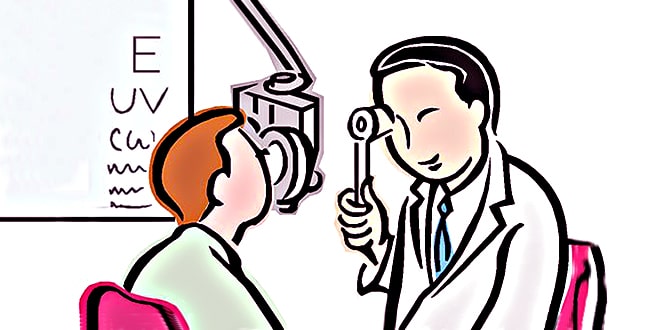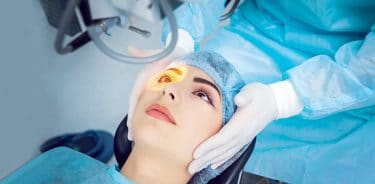Glaucoma is a very serious condition that causes damage to the eye’s optical nerve and lead to blindness due to the increased pressure inside the eye. It often occurs as a result of fluid accumulation in the eye and it is one of the most common causes of blindness especially in patients older than 60 years of age. This fluid accumulation damages the optic nerve by increasing pressure inside eye and lead to the development of glaucoma. However, blindness can be prevented if glaucoma is diagnosed early and treated accordingly. Glaucoma diagnosis is made by using eye tests that measure the pressure inside the eye. Generally it can be treated with tablets and eye drops, however, laser treatment or surgical operations may be necessary to lower the pressure inside the eye.
Table of Contents
What is glaucoma?
Glaucoma is known as high eye pressure or opthalmia in general public and it is a condition that damages the optic nerve and gets worse over time. It is generally associated with the increased pressure in your eye. Increased intraocular pressure can damage the optic nerve that transmits the images to your brain. It can cause permanent blindness within a few years if not treated.
Glaucoma can be inherited and may not develop until advanced ages. Most people with it have no early symptoms or pain. Therefore, it is important to have regular eye examinations so that glaucoma can be diagnosed and treated before long-term visual loss happens. If you are over the age of 40 and have a family history of glaucoma, you should get a complete eye examination every 2 years. If you have diabetes or other eye diseases, you should visit your doctor more often.
Types of glaucoma
Open-angle glaucoma
This type has a very slow course. Patients may not have any symptoms and a slight loss of vision may not even be noticed. Therefore, most people with this type of glaucoma cannot receive medical care until permanent damage occurs.
Open-angle glaucoma is generally seen in patients over the age of 50. It generally affects both eye but one eye remains in better condition than the other. Early diagnosis is very important. This allows you to get treatment via medication or surgery in order to slow the disease and preserve your vision.
Angle-closure glaucoma
Symptom development of glaucoma is generally acute and patients often suffer from pain and rapid loss of vision. Luckily, these symptoms force the patients to see a doctor and they can receive treatment before any permanent damage happens. Angle-closure glaucoma occurs when the fluid inside your eye is not drained properly. This fluid is removed from the eye via a narrow canal system located in the tissue mesh between the iris and cornea.
When the space between your iris and cornea becomes too narrow, the “angle” is closed. Sudden occurrence of this condition leads to acute attack.
Angle-closure is less common than the other types of glaucoma that gradually progress over time. Cataract, ectopic lens (displacement of your lens from its original location), diabetic retinopathy, ocular ischemia (narrow blood vessels in the eye) and uveitis (eye inflammation) are among the risk factors of this disease. In addition, the prevalence of angle-closure glaucoma is higher in women than in men.
Secondary glaucoma
This type means any condition that result in optic nerve damage and loss of vision due to an increased pressure in the eye due to another disease. It can occur as a result of eye injury, inflammation, tumor, advanced cataract and diabetes.
Some drugs like steroids can also cause secondary glaucoma. It can be painful or severe. Treatment type is decided based on whether it is open-angle or angle-closure glaucoma.
Childhood glaucoma (congenital glaucoma)
Childhood glaucoma can occur in very young children due to eye anomalies. This type develops due to the obstruction or dysfunction of the drain canals in the eye. Sensitivity against light, diplopia, watering of the eyes, enlarged eyes are the most common symptoms of childhood and infant glaucoma. Congenital type can also be caused by a genetic defect at birth or abnormal development.
Microsurgery can generally repair structural problems in uncomplicated childhood glaucoma cases. Other cases are treated with medication and surgery.
Who has glaucoma?
- African Americans over the age of 40 (ethnic origin is a higher risk factor)
- People with a family history of glaucoma
- Everyone over the age of 60 (especially Mexican Americans)
- People with abnormal optic nerve
- Migraine patients
- People with thin cornea
- Diabetes patients
- People with high pressure in the eye
- People using corticosteroids
Any previous eye disease history, hypertension, cardiac disease, use of systemic medication or eye medication are taken into consideration for diagnosis of glaucoma. In addition alcohol, tobacco or substance use of patients and potential presence of allergies against any medication are investigated. Therefore, glaucoma diagnosis is made as a result of an extensive examination.
Causes of glaucoma
The most important cause of is the accumulation of fluid in the front part of the eye. The fluid that should have been drained accumulates in the eye, increasing the pressure inside. Patients may permanently lose sight due to the death of optic nerve fibers that are damaged due to the increased intraocular pressure.
Farsightedness, hypermetropia, abnormal optic nerve anatomy, diabetes, previous eye surgery, migraine, thinned cornea, steroid use are among the other causes of glaucoma.
Glaucoma symptoms
The type of glaucoma is the determiner factor of symptoms. Generally, the early stages of open-angle glaucoma are asymptomatic. However, blind spots may develop in the later stages.
Angle-closure glaucoma symptoms
- Blurred vision
- Mild headache
- Mild eye pain
- Severe pain in the eye and forehead
- Eye redness
- Nausea and vomiting
- Decreased vision
- Seeing bright light spots and colored rings
These are the symptoms of advanced stage angle-closure glaucoma. However, similar symptoms may also occur in patients with advanced stages of open-angle type.
Glaucoma diagnosis
Diagnosis is performed with an extensive eye examination. Below tests can be used during eye examination for eye pressure measurement and eye pressure values:
Eye pressure tests
Visual acuity test
This eye test determines how well patients’ vision is over different distances.
Visual field test
This test measures peripheral vision ability, or side vision, and it is very important to determine whether peripheral vision loss is the cause of glaucoma.
Dilated eye examination
In this examination, drops are used to widen the pupils and your eye doctor views you retina and optical nerves to determine whether there is any damage.
Tonometry
The pressure inside the eye is measured by using a device called tonometry. Your doctor will put numbing eye drops in your eyes in the tonometry method. And the pressure inside your eyes is measured.
Pachymetry
Pachymetry is the method of measuring the thickness of cornea. Numbing drops are placed and an ultrasonic drop instrument is used to measure cornea thickness and determine whether there is cornea thinning.
Glaucoma treatment
Glaucoma treatment is determined based on the type of it. Your doctor prescribes the necessary medication and eye drops after determining your type. If the desired results are not achieved, laser or surgical treatment methods can be used. Most common methods used for glaucoma treatment are:
Glaucoma treatment with eye drops and medication
For the treatment of early stage glaucoma, eye drops and tablets are prescribed. These drugs lower the pressure if used regularly. And they also help the drainage of the fluid inside the front part of the eye.
These drugs must be used as instructed and prescribed by the doctor. In case of any side effects, consult your doctor and follow their recommendations.
Glaucoma treatment with laser and Laser surgery
Your doctor may choose laser treatment in order to drain the fluid that causes increased pressure. The condition of the drainage holes are improved with the light beam delivered through the lens of the laser machine during the laser surgery. This way, the fluid inside eye is drained easier and faster. However, there may be some unwanted side effects like inflammation in your eye after laser surgery. Your doctor will prescribe eye drops to avoid such condition.
If there is glaucoma in both eyes, treatment for the other eye can be initiated a few days after the first treatment.
Glaucoma surgery
If eye drops and laser treatment does not give the desired results, your doctor may decide to treat it with surgical operation. This operation is called trabeculectomy and it is performed in an operating room with traditional methods.
During the operation, a small tissue is removed from the eye in order to open a canal in the eye for drainage purposes. Patients may experience infection and inflammation in the eye after the operation. Eye drops are used to prevent this.
Intraocular pressure can be decreased by 80% with glaucoma surgeries. However, such operation can lead to side effects like low eye pressure, cornea problems etc .If you encounter any of these, consult your doctor.
How to lower eye pressure?
Glaucoma responds well to the treatment in case of early diagnosis and correct treatment. Regular eye examinations and using the prescribed eye drops and tablets as instructed by your doctor is very important for lowering your intraocular pressure. If your doctor deems necessary, do not worry about laser or surgical operation. Because glaucoma can cause serious consequences like permanent loss of vision if left untreated.
Glaucoma medications and eye drops
Zaditen, Acular, Eifel, Cebedex, Tidomix are among the most common medications used for glaucoma treatment.
Glaucoma drugs may have some side effects. In such case, you may consult your doctor and ask them to change your glaucoma medication and restore your eye pressure by regular use of the eye drop. For more:>>> Glaucoma




